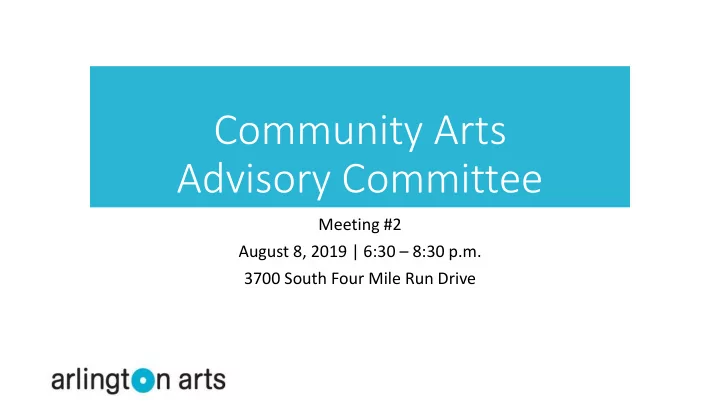

Community Arts Advisory Committee Meeting #2 August 8, 2019 | 6:30 – 8:30 p.m. 3700 South Four Mile Run Drive
agenda INTRODUCTIONS – 20 minutes MOVING FORWARD – 85 minutes • Welcome • Overview of Tools & Models • Introductions • Subcommittee Report Out • Remarks from County Board Member Scene Shop/Costume Lab; Joint Use; Mobile Stage – 5 minutes per subcommittee Katie Cristol • Summary of discussions (including rubric) • Information required • Next meeting date LEVEL SETTING – 5 minutes • Criteria Evaluation & Model Building • Ground Rules, Expectations & Responsibilities • Introduction of template – including rubric evaluation tool and model building • Review of Project Scope & Work Plan • Agreement on overarching goals, success criteria and measures for each service 2
introductions welcome introductions remarks 3
level setting ground rules, expectations & responsibilities review of project scope & work plan 4
expectations & ground rules & working agreements responsibilities • Listen to each • Think creatively • The process is explicit, rational, and fair. Agreements other • Remain positive • I was treated well and my inputs were create a safe • Participate fully and forward heard. space for looking • Respect and • I can live with and commit to the outcome. dialogue, critical share air time • Speak for conversation yourself, not on • Be brief – share and decision- behalf of others air time making, while • Differences of aiming to create • Assume positive opinion are equity of voice intent natural and for this work. • One person talks useful at a time – signal intent to speak (using name from consensus prime – decision making tents)
project scope 1. catalogue public and private arts services in arlington and the region to include audio-visual services, costumes and scenery construction; 2. develop and analyze alternative management and service delivery proposals and funding sources for scenic studio, costumelab and mobile stage operations including a proposed transition for future operations; 3. evaluate and propose public-private partnerships for audio-visual services, costumes and scenery construction; 4. develop a new scheduling process for joint-use theater space in partnership with arlington public schools. 6
work plan review & discussion of October 31 October 15 initial scenario July 15 research Initial scenario final scenarios final final draft analysis; pros & methods; building and analysis & recommendations first meeting #1 recommendations cons; key establish evaluation actionable items to county of CAAC & actionable questions descriptors; manager items develop review criteria july, august, september, october 7
moving forward overview of tools & models subcommittee report out criteria evaluation & model building 8
subcommittee report out Scene Shop and CostumeLab Mobile Stage Joint Use Theater Scheduling Maggie Boland Pryalal Karmakar Pam Farrell Sara Duke Amy McWilliams Carol Cadby Jane Franklin Kat Williams Ava Boston and Yasmina Tom Prewitt Mansour Steven Yates Janet Kopenhaver Alex Bryce Leslie Peterson Matthew Randall FIVE MINU NUTE TES O OR L LESS SS… o summary of discussions (including rubric) o information required o next meeting date 9
a suggested framework: five steps for each service: 1. define the service 2. describe the overarching goal for the future state of the service 3. define the factors that will determine the achievement of this overarching goal (criteria), how these will be measured and what you consider the ‘optimal state’ indicators for these measures 4. generate ideas/scenarios for the service 5. evaluate the ideas /scenarios against the optimal indicators and the current state, and summarize the results 10
criteria evaluation & model building feedback cost to county public cost to users management arrangements cost sharing cost to private partners public partnership cost to non-profit partners criteria alternative public contracted process to use efficiency models service delivery public private partnership direct users equity of access private consortium percentage of use by each user quality of facility/service private overall effectiveness 11
tools & models 12
criteria evaluation & model building • Overarching goals, success criteria and measures for each service 13
Overarching goals – meeting discussion • Scene Shop & CostumeLab • Costumes for production (if needed) – to communicate the character; drama & story • Quality of production • Better audience experience • Community participation in the shop • Employment of technicians • Education/learning • How to use equipment • History via costumes • Enriching the community • Entertainment & cultural expression 14
wrap up finalize criteria sub-committee work schedule meeting(s) initial alternative model building next meeting: August 29 @ 6:30 pm 15
Recommend
More recommend